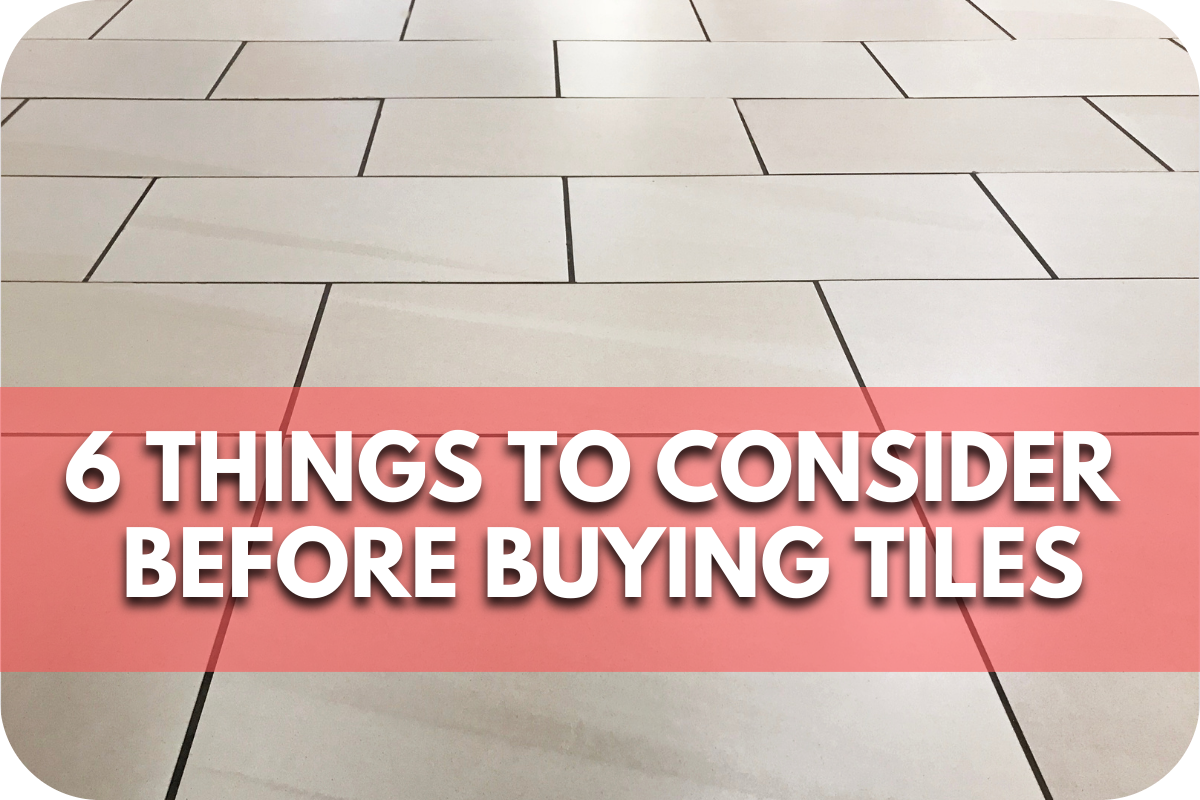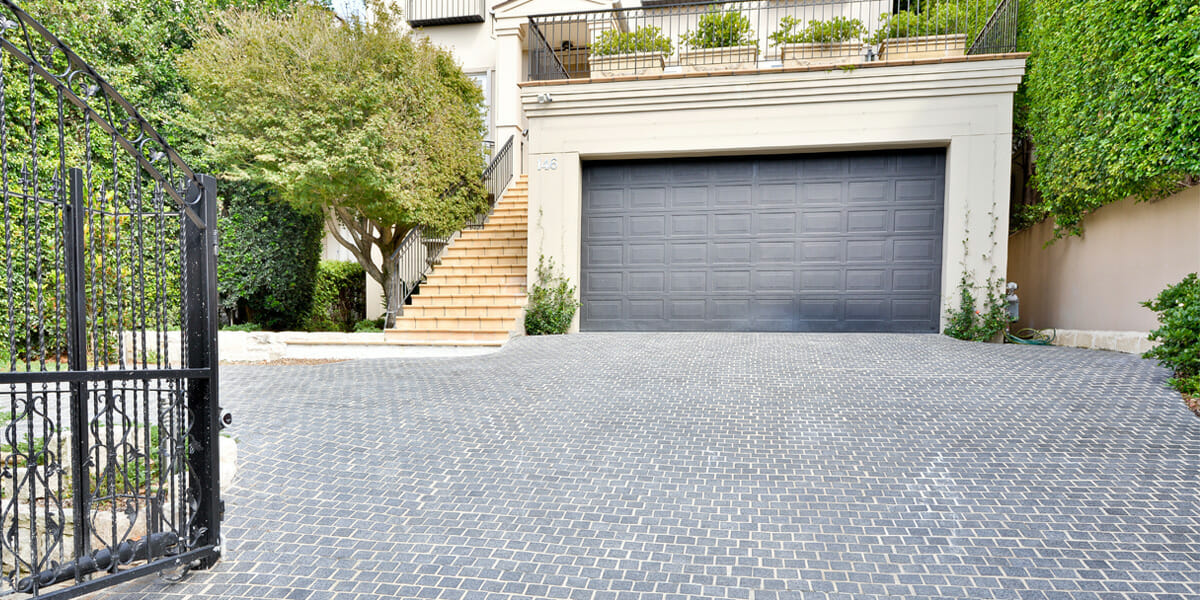
Choosing the right tiles can be overwhelming, with so many options available.
Without proper guidance, you might end up with tiles that don’t suit your space, are difficult to maintain, or exceed your budget.
To help you make an informed decision, we’ve outlined six essential factors to consider before buying tiles. Read on to ensure you select the perfect tiles for your home or project.
1. Determine the Purpose of the Tiles
The first crucial step in a tile-buying journey is determining the tiles’ purpose. Understanding where and how the tiles will be used can significantly influence your choices, ensuring you select the most suitable option for your needs.
Indoor Tiles are generally less exposed to the elements and extreme conditions. They can range from the highly decorative, such as mosaic tiles for feature walls, to the more functional, like ceramic tiles for kitchen backsplashes. Indoor tiles often prioritise aesthetics, slip resistance, and ease of cleaning.
Outdoor Tiles need to be durable, weather-resistant, and often non-slip. Porcelain tiles are a popular choice for outdoor use due to their low porosity and high durability. Natural stone tiles like slate or granite can also be excellent for outdoor applications, adding a touch of elegance and ruggedness to patios and garden paths.
Floor Tiles are designed to withstand significant wear and tear. They are generally thicker and more robust, capable of handling the weight and traffic of daily use. Floor tiles also need to have a certain level of slip resistance, especially in wet areas like bathrooms and kitchens.
Wall Tiles are often thinner and lighter than floor tiles, focusing more on aesthetic appeal and ease of cleaning. They can be used to create stunning features.
2. Choose the Right Material
Choosing the right material for your tiles is crucial as it affects their aesthetic appeal, durability, maintenance, and suitability for specific areas. Here are some common tile materials and their characteristics.
Porcelain tiles are known for their strength, durability, and low water absorption rates. They are made from refined clay and fired at higher temperatures, making them more robust than ceramic tiles.
Due to their resistance to moisture, stains, and scratches, porcelain tiles are suitable for both indoor and outdoor applications.
Ceramic tiles are made from natural clay and are often used in residential applications. They are versatile and available in various styles, colours, and finishes. Ceramic tiles are more affordable than porcelain tiles but are less durable.
Natural Stone tiles include marble, granite, limestone, and travertine. Each type of natural stone has unique characteristics, making it highly sought after for its beauty and uniqueness.
Marble is known for its luxurious appearance and is often used in high-end bathrooms and living spaces. However, marble is porous and can be prone to staining and scratching.
Granite is extremely durable and resistant to scratches and heat, making it ideal for kitchen countertops and high-traffic areas.
Limestone offers a natural, earthy appearance and is suitable for indoor and outdoor applications. However, it requires sealing to prevent stains and damage.
Slate is durable and slip-resistant, perfect for outdoor areas and high-traffic spaces. Its natural cleft surface adds texture and visual interest.
Travertine is known for its warm, natural tones and is often used in bathrooms and outdoor patios. It is porous and requires regular sealing to maintain its appearance.
3. Consider Tile Size and Shape
When selecting tiles, size and shape play a significant role in the overall look and functionality of the space. The right choice can enhance the aesthetic appeal, create the illusion of more space, or add unique visual interest.
Standard Sizes
Tiles come in various standard sizes, each suitable for different applications and design preferences. Here are some common sizes and their typical uses:
- 4×4 Inches: Often used for backsplashes and accent walls.
- 6×6 Inches: Suitable for small spaces and feature areas.
- 12×12 Inches: Versatile size, commonly used for floors and walls in both residential and commercial spaces.
- 18×18 Inches: Ideal for larger spaces, creating a seamless and spacious look.
- 24×24 Inches: Great for expansive areas, offering a modern and luxurious feel.
Large Format Tiles
Large-format tiles are becoming increasingly popular for their sleek and contemporary appearance. They range from 24×24 inches to 48×48 inches or larger and offer bold, seamless surfaces.
Mosaics and Small Tiles
Mosaic Tiles are small tiles, typically less than 2×2 inches, often mounted on mesh sheets for easy installation. They are perfect for adding intricate patterns, borders, and accents to your design. Mosaics can be made from various materials, including glass, ceramic, porcelain, and natural stone.
Shapes
Tiles come in various shapes beyond the standard squares and rectangles, allowing for creative designs and unique patterns:
- Hexagon: Popular for modern and retro designs, it adds geometric interest.
- Subway: A classic rectangular shape is often used in a brick pattern for a timeless look.
- Chevron and Herringbone: Create dynamic, zigzag patterns that add movement and visual interest.
- Penny Round: Small, round tiles that offer a playful and vintage vibe.
4. Evaluate Tile Finish and Texture
Evaluating the finish and texture of tiles is crucial in determining their suitability for different spaces and purposes. The finish and texture affect not only the visual appeal but also the functionality and maintenance of the tiles.
Glossy vs. Matte
Glossy tiles have a shiny, reflective surface that can make spaces appear larger and more vibrant. Due to their easy-to-clean nature, they are often used in bathrooms and kitchens. Matte tiles have a non-reflective, flat surface that offers a more understated and sophisticated look. They are often used in living, outdoor, and high-traffic areas.
Textured vs. Smooth
Textured tiles have a rougher surface, adding depth and interest to the design. They are particularly useful in areas where slip resistance is a priority, such as bathrooms, kitchens, and outdoor areas. Smooth tiles have a flat surface that offers a sleek and clean look. They are commonly used in modern and minimalist designs.
Slip Resistance
Slip resistance is critical, especially for flooring in wet areas like bathrooms, kitchens, and outdoor patios. Tiles’ slip resistance is often measured by the Coefficient of Friction (COF). A higher COF indicates better traction.
5. Assess the Colour and Design
Assessing the colour and design is crucial when selecting tiles for your space. The right choice can transform a room, adding character and enhancing the overall aesthetic.
Begin by considering the room’s existing colour palette. Opt for tile colours that complement or contrast stylishly with your current décor. Neutral tones, like beige, grey, and white, offer versatility and timeless appeal, while bold colours can create a striking focal point.
Next, think about the design and pattern of the tiles. Large-format tiles with minimal patterns can make small spaces appear larger and more open. Intricate designs or mosaic patterns can add texture and visual interest to a plain area.
Additionally, consider the finish of the tiles—glossy tiles reflect light and can brighten a room, whereas matte tiles offer a subtle, sophisticated look.
Always request tile samples and view them in your space under different lighting conditions to ensure they meet your expectations. The interplay of natural and artificial light can significantly alter the appearance of the tile’s colour and design.
6. Calculate Costs and Budget
Understanding the financial commitment is essential when purchasing tiles. Calculating costs and establishing a budget will prevent unexpected expenses and ensure your project stays on track.
Start by measuring the area you plan to tile and calculating the required square metres. To avoid running short, include an additional 10-15% for cuts and breakages.
Next, research the cost per square metre of your chosen tiles. Prices can vary significantly depending on the material, design, and quality. Porcelain and natural stone tiles tend to be more expensive than ceramic ones. Factor in the cost of adhesive, grout, and sealant, as these materials are necessary for installation.
Labour costs should also be considered if you plan to hire professionals. Get multiple quotes to find a competitive rate. If you’re doing it yourself, account for the cost of tools and any potential learning curve.
Remember to budget for maintenance costs, especially if you choose natural stone tiles, which may require periodic sealing. A clear, detailed budget will help you make informed decisions and avoid overspending.
Conclusion
Selecting the perfect tiles for your home involves carefully considering various factors to ensure aesthetic appeal and functional suitability.
By following these 6 essential steps, you can make an informed decision that aligns with your design vision and practical needs.
More To Explore

Grey Granite Cobblestones for Driveways: Strength and Style
Grey granite cobblestones combine strength, safety, and timeless appeal, making them a popular choice for Melbourne driveways and outdoor spaces. Their natural flamed texture offers

Granite Wall Cladding Melbourne: Modern and Classic Appeal
Granite wall cladding brings both modern sophistication and classic charm to Melbourne architecture. Known for its durability and natural beauty, granite transforms façades, feature walls,


